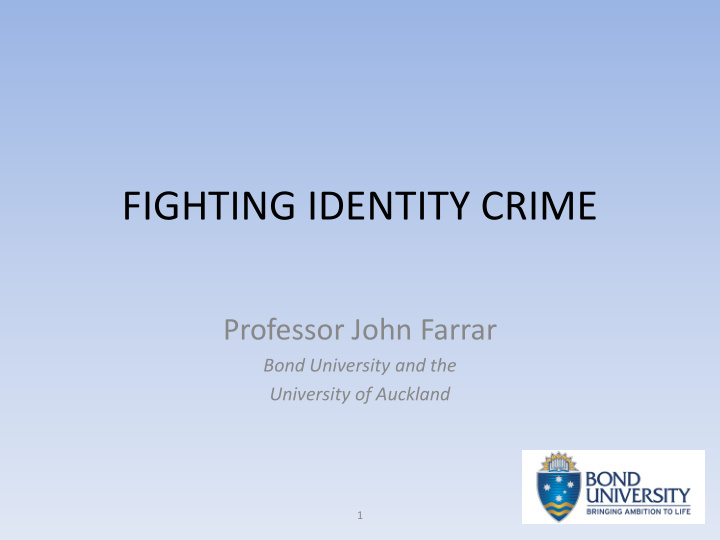



FIGHTING IDENTITY CRIME Professor John Farrar Bond University and the University of Auckland 1
Identity crime is on the increase. The cost is increasing. The cost includes a substantial cost relating to resources to combat identity crime. Total costs in Australia 2001-2002 estimated at $1.1 billion. More recent estimate in the United Kingdom 25 pounds for every adult in Britain. 2
The Concept of Identity and Proof of Identity Identity is an aspect of human personality. Early legal systems did not have a problem because population was largely static. Today with greater mobility and development of technology there is a massive increase in risk particularly with credit cards and electronic banking. 3
Identity is linked with citizenship and licences as well as access to credit. Increased sophistication in encryption. 4
Terminology Identity Crime – offences in which a perpetrator uses a false identity in order to facilitate the commission of a crime. Identity Fraud – the gaining of money, goods, services or other benefits through the use of a false identity. Identity Theft – the theft of a pre-existing identity 5
Techniques of Identity Crime Dumpster diving • Wallet theft • Mail interception and scams • Skimming • Proof of identity replication • Phishing • Vishing • Pharming, and • Spear phishing • 6
Jurisdictions with Specific Identity Crime Offences New Zealand has a number of sections in the Crimes Act 1961 relating to fraudulent use of identity to obtain a benefit. Amendments in 2003 updated provisions relating to a computer crime. 7
In Australia South Australia, Queensland, Victoria and New South Wales have specific offences relating to identity crime. There is a Bill before the Western Australian Parliament. The United Kingdom has a generic offence of Fraud in the Fraud Act 2006 and they have also introduced identity cards. 8
Profiling Fraudsters The Australian Institute of Criminology and PriceWaterhouseCoopers produced a useful Report “Serious Fraud in Australia and New Zealand” in 2003. 9
General characteristics of fraudsters mean age early 40s-42 for females, 43 for males. Relatively high proportion had completed High School education or had an Undergraduate tertiary degree. 44% had previous criminal record. Main motivation – greed, gambling and financial stress. 10
Recent Australian research classifies identity fraudsters into : 1. Organized crime 2. Sophisticated individuals 3. Opportunist individuals 4. An agent of the victim Increased use of websites like Facebook. 11
Sentencing Identity Fraudsters Little published information but matter recently considered by The Court of Criminal Appeal of the Supreme Court of New South Wales in Stevens v. R . [2009] NSW CCA260 (28 October 2009). This was before the new amendments specifically dealing with identity crime had come in. New provisions increase maximum penalties. 12
Accused charged with using false instrument with intent, possession of fake travel documents and obtaining benefit by deception. Trial Judge emphasized deliberate and planned course of systematic dishonesty. Need to denounce conduct, punish him and deter others. Appellate judges agreed and made general remarks about the social costs of identity crime. 13
For sentencing for hacking the identity of a sewerage pump see R v. Boden [2002] QCA 164. 14
Combating Identity Fraud Developments in cryptography and technology: Tamper proof plastic cards • Tamper proof documents • Firewalls and encryption software • Remote frequency ID chips • 15
“Cryptography like Batman, kind of menacing but on the side of justice.” 16
Conclusion Identity crime on the increase, costly and difficult to combat. Need for uniform laws with adequate penalties. 17
Need for more detailed research on profiling identity criminals and connection with organized crime. Plenty of work for experts to devise protective security alarms. The problem will not go away. 18
Recommend
More recommend